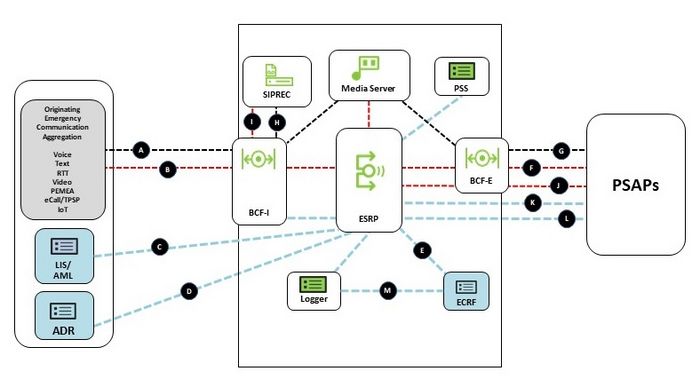Developer Program - OpenScape First Response ESInet/NGCS Solution
The Wiki of Unify contains information on clients and devices, communications systems and unified communications. - Unify GmbH & Co. KG is a Trademark Licensee of Siemens AG.
The components in the OpenScape First Response ESInet/NGCS Solution are implement to be compliant to both the North American (NENA) and European (ETSI/EENA) standards. Projects outside North America and Europe will tend to use the ETSI/EENA standards, so the solution can be deployed anywhere in the world.
All external interfaces provided by the solution will be compliant to the applicable standards. This page will enumerate these interfaces and describe which standards apply. Internal interfaces between solution components provide by Unify/Atos will not be described here.
Contents
- 1 Incoming Emergency Call SIP Interface
- 2 Incoming Emergency Call RTP Interface
- 3 Outgoing Call to PSAP SIP Interface
- 4 Outgoing Call to PSAP RTP Interface
- 5 SIP Event Package Interface
- 6 SIP Location Update Interface
- 7 Dequeue Registration Service Interface
- 8 Bad Actor Service SIP Interface
- 9 Location De-Reference SIP Interface
- 10 Location to Service Translation Interface
- 11 Additional Data Repository Query Interface
- 12 SIPREC Recording Call Control Interface
- 13 SIPREC Recording Media Interface
- 14 Event Logging Interface
Incoming Emergency Call SIP Interface
All emergency calls arriving at the BCF interface to the ESInet are signaled via the Session Initiation Protocol (SIP). In North America, per the NENA standards, calls on this interface are expected to provide links to additional data structures in Call-Info headers, but the solution can handle calls without these links. Per ETSI/EENA standards the inclusion of links to additional data are optional and are only of interest to the PSAP.
The SIP interface to the NGCS solution is compliant with RFC 3261 and to the relevant sections of the NENA i3 document and ETSI TS 103 479.
This interface is represented by the dotted red line B in the diagram above.
There have been no changes to this interface in recent versions of the NGCS solution.
Incoming Emergency Call RTP Interface
The media for all emergency calls arriving at the BCF interface to the ESInet are carried using RTP, with the exception of Text to 911 calls where the message contents are carried via MSRP (Message Session Relay Protocol). Media carried via RTP include voice, video and Real-Time Text (RTT). The BCF will serve as an anchor point for all media streams entering the ESInet, where the media will be routed to the far-end PSAP (via the egress BCF) and also to the SIPREC recording server if recording is to be performed. Depending on the configuration of the network, the ingress BCF will either route the media to a media server bridge (a conference-aware configuration) or directly to the egress BCF (when ad-hoc conferencing is used).
The BCF RTP interface is compliant to RFC 3550. Note that the ability of the answering PSAP to understand the media being sent is dependent on the availability of the appropriate codecs.
This interface is represented by the dotted black line A in the diagram above.
There have been no changes to this interface in recent versions of the NGCS solution.





